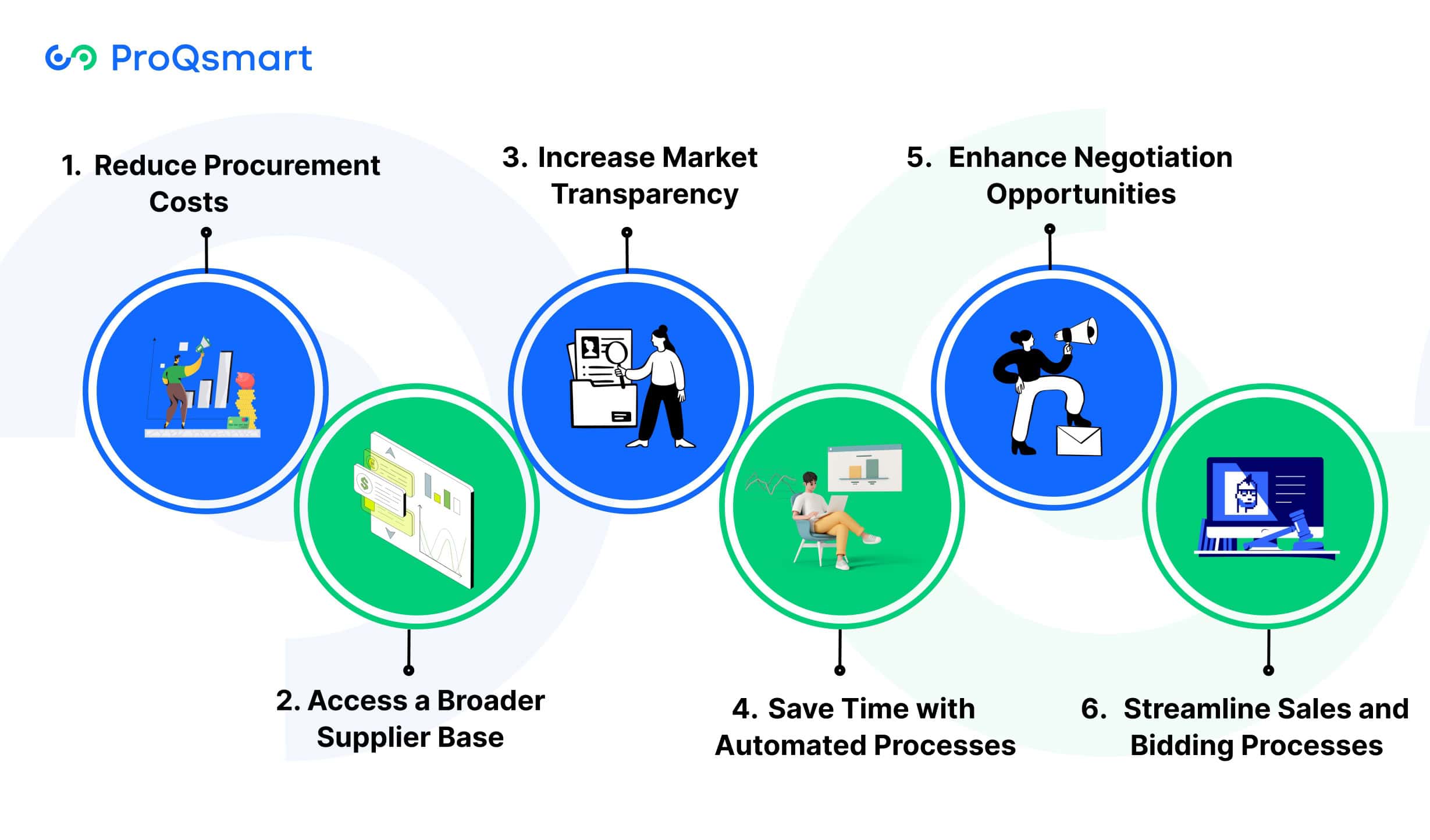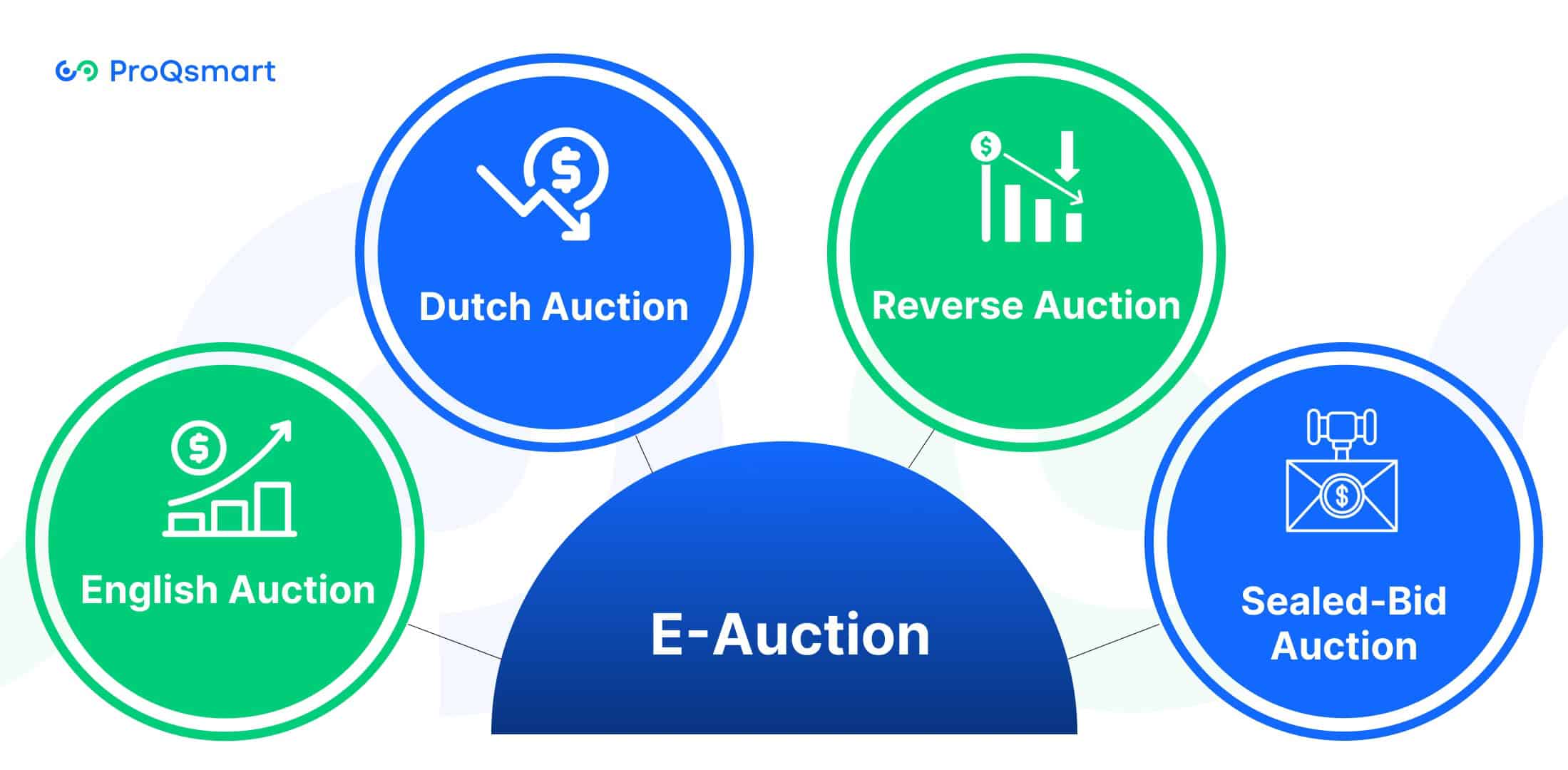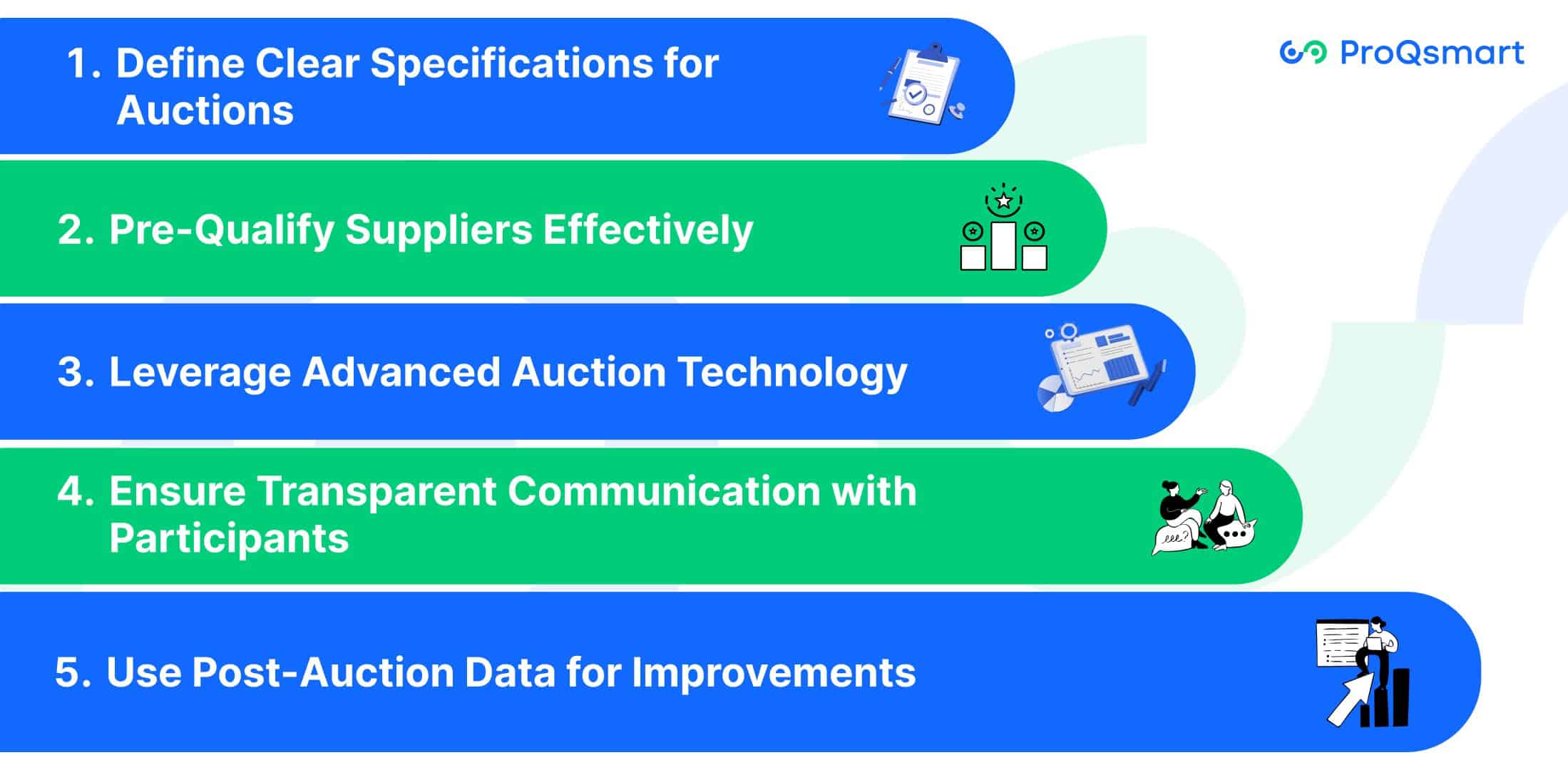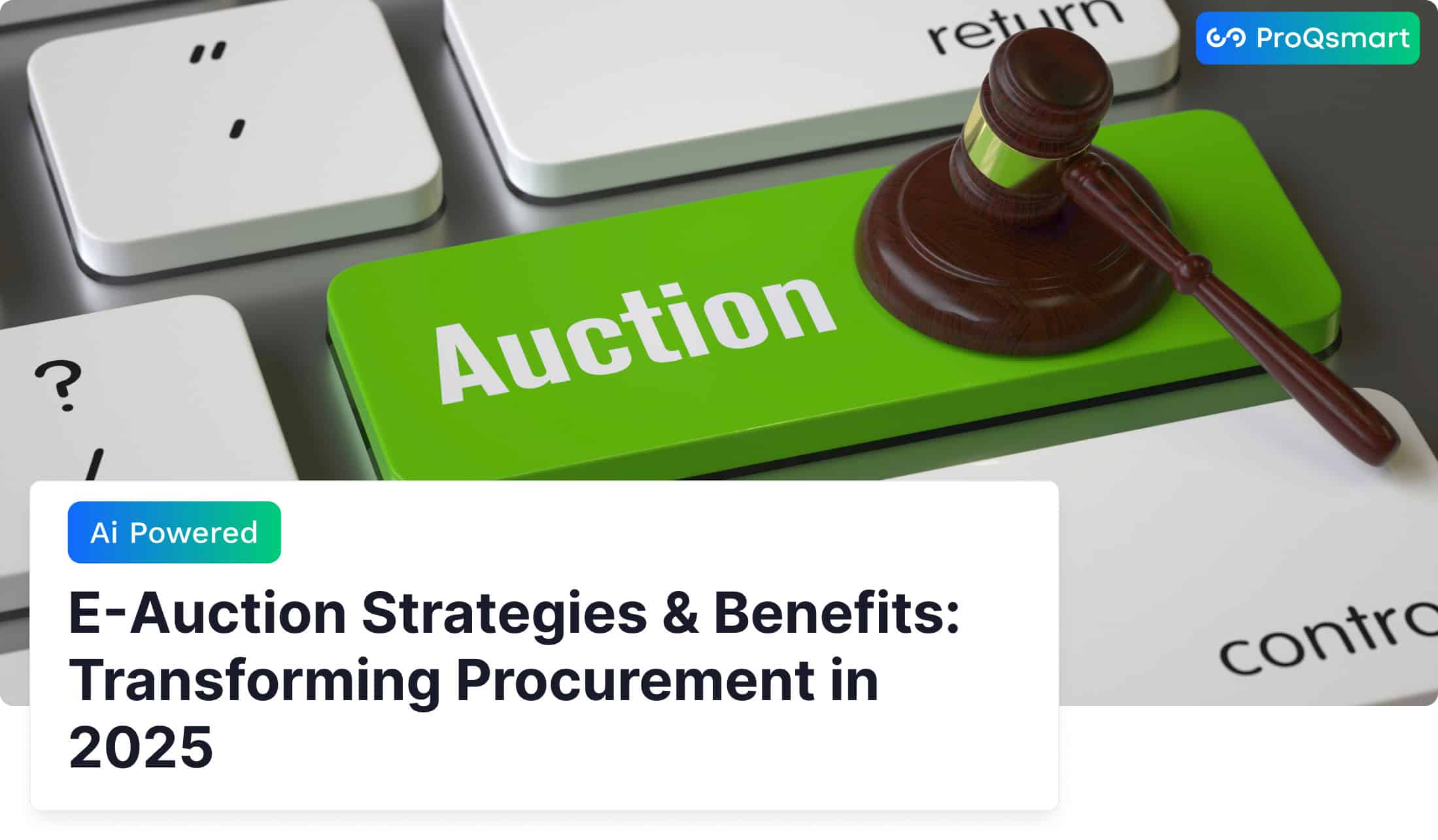E-Auctions are an essential vehicle for online procurement, simplifying the supplier choosing process while encouraging competitive pricing. By conducting live, competitive auction events, agencies and organizations can select suppliers more transparently and efficiently. This ensures that their procurement dollars stretch further. This approach greatly shortens procurement cycles and enhances the quality of negotiation outcomes by fostering a more dynamic and data-driven environment.
Progress in technology has completely changed the landscape of e-auctions. Today, they offer advanced automated bid analysis, customizable auction formats, and secure online platforms. These advancements have leveled the playing field for businesses large and small. Procurement professionals are constantly checking their motives to save costs and improve supplier relationships.
E-auctions provide a proven, powerful, low-cost tool expressly yielded to meet these goals. As their adoption becomes wider, it further emphasizes their importance in today’s procurement strategies.
What Are E-Auctions?
E-Auctions are competitive electronic bidding events that occur online. Here, buyers and sellers interact live to determine the best terms and pricing in an open and competitive environment.
These platforms create a dynamic, competitive marketplace in which buyers are better able to find cost-effective goods and services. Simultaneously, sellers are incentivized to put their best prices forward. E-Auctions use known bidding formats, they have time limits on auctions, and they have robust security mechanisms that ensure fair and transparent operations.
For example, a procurement team purchasing raw materials can initiate an eAuction. In this arrangement, suppliers competitively bid on their products to the supplier’s auction in a set period of time.
Participants, known as bidders, compete by submitting offers—called bids—until the auction ends. Sophisticated security technologies such as encryption work behind-the-scenes to ensure that all online transactions are secure. This helps create confidence in the process for buyers and sellers alike.
How E-Auctions Work?
The E-Auction process starts with buyers determining their needs and issuing an RFX to invite suppliers to bid. Auction software is key, running the show from bid submission to real-time updates.
Suppliers compete against one another in real time during the live event, with notifications notifying them of any bid disruptions, like being outbid. Intuitive, user-friendly platforms improve accessibility and user experience, making it easier for all participants—even those who aren’t as technologically savvy—to engage and bid effectively.
Benefits of E-Auctions for Buyers and Suppliers

1. Reduce Procurement Costs
E-Auctions are an effective strategy for buyers looking to achieve substantial cost savings in procurement, typically ranging from 10% to 20%. By leveraging competitive bidding, suppliers compete in real-time to offer the best prices, driving down costs for organizations sourcing materials.
These auctions streamline the procurement process by standardizing terms and conditions, making it easier for buyers to negotiate volume discounts. E-Auctions not only enhance supplier competition but also provide valuable analytics and insights into bidding trends, helping buyers identify the best value suppliers.
Ultimately, e-Auctions are a vital tool for buyers aiming to maximize their procurement budgets while maintaining quality and strong supplier relationships.
2. Access a Broader Supplier Base
Perhaps the most intriguing benefit of e-Auctions is the opportunity to reach more diverse suppliers. Buyers are able to reach both local and global vendors through online platforms, leveling the playing field and providing more options. This broader supplier pool encourages competition, which often leads to more favorable pricing alternatives and creative solutions.
For example, small businesses from any locality can now compete on the same playing field as large corporations – often offering new and innovative ideas. Supplier diversity thus becomes a cornerstone of strategic procurement, enabling buyers to make their procurement practices more strategic and better aligned with sustainability and inclusivity goals.
The larger supplier base decreases dependence on established suppliers, leading to fairer and more competitive procurement results.
3. Increase Market Transparency
Market transparency is one of the core features of e-Auctions and buyers are able to see exactly what is happening with pricing and bidding activity. This process allows for all participants to compete on an equal playing field, with bids displayed in real-time. Through this transparency, fair competition is encouraged, and buyers are better able to make smart, data-driven decisions.
Increased transparency creates an atmosphere of trust among buyers and suppliers, helping develop longer-term partnerships that extend past individual transactions.
4. Save Time with Automated Processes
Unlike traditional procurement processes, which can take days or weeks, e-Auctions can happen in less than an hour. Automation removes the manual tasks, like processing the bid or sending out notifications, dramatically lowering the administrative overhead. Automated systems can provide instant notifications to suppliers about bid changes, saving time and effort while building supplier trust and loyalty through improved communication and efficiency.
Organizations rely on streamlined workflows too. E-Auctions create uniform procurement processes. At this level of consistency, cross-functional teams can start to build more strategic best practices and spend more time on strategic initiatives instead of operational items.
That time savings means faster decisions and quicker contract awards so businesses can be more nimble in their competitive markets.
5. Enhance Negotiation Opportunities
Because e-Auctions put all bidders in a competitive environment, they serve to bolster buyers’ negotiating power. By incentivizing suppliers to put forth their best terms in real-time bidding, escalation in price by incumbents is mitigated. A buyer that is negotiating with incumbent suppliers can use the bids from new entrants as leverage.
This strategy allows them to obtain more favorable pricing and terms. The fast-paced nature of e-Auctions allows for buyers to view several bids at once, to see what the best offers are right now.
Direct communication between buyers and suppliers helps narrow negotiations even further, making sure everyone is on the same page about what is most important. Through e-Auctions, organizations position themselves to achieve competitive benefits, realizing value through streamlined and impactful negotiation strategies.
6. Streamline Sales and Bidding Processes
E-Auctions make the sales process easier, faster and more efficient by automating and structuring the bidding process. Suppliers avoid time-consuming negotiations and go directly into auctions. These auctions conclude within an hour, allowing them to save valuable time and resources.
Thanks to automated bid submissions, suppliers can focus on evaluating and responding to multiple bids quickly and efficiently through an auction. This increases their ability to win more contracts. For instance, a supplier might present several competing offers with different terms to address various buyer requirements.
Standardization of the e-Auction process creates a level playing field that eliminates many administrative burdens. This simplified process allows suppliers to focus their efforts on providing the best possible products and services.
Types of E-Auction Formats

English Auction Format
The English auction format is perhaps the most simple and well-known e-auction style. In this format, bids continually raise the price as bidders fight in full view of one another, with each new bid higher than the last. The transparent and competitive environment ensures market forces drive up final bids.
This technique is especially effective when selling one-of-a-kind or in-demand products. For procurement teams, English auctions are commonly employed for commodities such as metals or raw materials where market-driven pricing is a must. For instance, a manufacturing company sourcing steel may use this format to secure competitive rates while ensuring the quality matches their standards.
The auction format creates a competitive and high energy environment where you’re motivated to outbid your competition, all of which works to the seller’s advantage.
Dutch Auction Format
In a Dutch auction, the reverse occurs. The price starts high and decreases stepwise until a bidder agrees to the prevailing price. This format is prized for its speedy nature and efficiency, particularly in instances where time-sensitive decisions are required.
It creates extreme upward pressure on suppliers, since there is no rebid opportunity. A typical buyer in a Dutch auction might be looking for perishable goods or excess stock. For instance, a food distributor might use this approach to move inventory fast in order to avoid spoilage.
Doing proper buyer research allows you to establish the most effective starting prices. This method accelerates transaction times and focuses value where both parties see it.
Reverse Auction Format
Reverse auctions turn the traditional auction model on its head, with suppliers competing to provide the lowest price. This format is especially beneficial to the most cost-conscious buyers who want to save taxpayer dollars through less expensive procurement.
Suppliers compete to offer the most competitive bids to keep or move up in their rankings, typically resulting in significant cost savings. For instance, private sector companies like those in the construction industry have adopted reverse auctions to procure large quantities of materials.
Sealed-Bid Auction Format
The sealed-bid auction format is one where bidders submit bids anonymously and no one knows what others’ bids are. This confidentiality protects against collusion and bid rigging by making sure that every single bid represents a true judgment of value.
Sealed-bid auctions are favored in situations where privacy is of the utmost importance, like government contracts or high-stakes procurement contracts. Defense contractors love this format because it guarantees them equipment contracts.
All the while, they protect the integrity of the bidding process. Through the prevention of outside influence, sealed-bid auctions ensure fairness and trust, making them a reliable option for industries that value confidentiality.
Best Practices and Strategies for Conducting E-Auctions

Define Clear Specifications for Auctions
Detailed specifications are the foundation of any successful e-Auction. Accurate, organized, and detailed auction documents not only ensure clarity in the process, but encourage the most appropriate, competitive bidders to the auction. When an agency or contractor is procuring steel, they will need to specify the grade, size, and delivery schedule of the material.
This enables suppliers to determine if they can realistically meet the demand. Clear criteria provide participants with the tools they need to submit the most competitive bids possible, eliminating ambiguities that can result in wasted time or litigation. In addition, when specifications serve the broader organizational mission, like promoting sustainability or cost efficiency, they lead to superior results.
An auction document that’s better defined than a loose guideline encourages both parties to use the document as a roadmap to make the process even better.
Pre-Qualify Suppliers Effectively
Pre-qualification is an essential part of the process, protecting you by making sure that only qualified suppliers compete in your e-Auctions. Shortlist suppliers based on financial stability, performance history and technical capability. Taking these steps will increase competition and further reduce your risks.
For instance, if you’re sourcing construction services, pre-qualifying vendors based on their certifications and experience ensures robust competition. This pre qualification step helps eliminate unqualified bidders, leading to a more efficient auction process. A thorough pre-qualification process enhances the quality of the auctions, ultimately resulting in better project outcomes.
Moreover, it creates an atmosphere of trust and transparency, helping participants feel confident that they will have a fair, competitive opportunity.
Leverage Advanced Auction Technology
Technology is an essential piece of today’s e-auction landscape. User-friendly online auction platforms such as ProQsmart provide real-time bid tracking, automated notifications to streamline competitive bidding, and secure transactions. These features come together to create a frictionless experience for both purchasers and suppliers in the online auction market.
For instance, auction software that accommodates dynamic bidding fosters a more competitive environment, leading to significant savings. Advanced auction tools further enhance workflows, saving time and reducing risk. When procuring complex machinery, electronic auction platforms that offer advanced visualization capabilities or sophisticated reporting tools can assist buyers in making well-informed decisions.
Protecting the integrity of the electronic auction platform is just as crucial as its security, ensuring sensitive data is safeguarded while instilling confidence among participants.
Ensure Transparent Communication with Participants
Open and transparent communication between e-Auction platforms and participants is key. Providing timely updates about auction timelines, procedures, and expectations helps participants prepare effectively. To that end, providing a pre-auction briefing as an example, to answer frequently asked questions and ensure everyone is on the same page.
During the auction, clear notifications about bid status or time remaining maintain transparency and excitement. Quickly answering questions can clear up confusion and show all bidders an interest in a fair process. Clear, consistent communication throughout the process helps you encourage more participation and create a positive auction experience.
Use Post-Auction Data for Improvements
Post-auction data is a valuable asset for refining future strategies. Analyzing this data provides insights into supplier behavior, pricing trends, and bidding patterns. For example, monitoring real-time supplier price movements during auctions reveals competitive dynamics and optimization opportunities.
By learning from past auction results, organizations can make informed decisions and identify flaws in their auction strategies, such as overly tight opening bid increments that hinder competition. Responding to these insights allows procurement teams to continually adjust their approaches for greater effectiveness. Real-world examples demonstrate that organizations that analyze and apply lessons learned from past auctions can streamline their processes, enhance supplier engagement, and achieve greater success in future auctions.
Future Trends in E-Auctions
As we look toward the future of e-Auctions in procurement, several key trends are emerging that will shape their effectiveness and adoption.
1. Enhanced Digital Transformation
The integration of advanced technologies such as AI, machine learning, and blockchain will revolutionize e-Auctions. These technologies will enable real-time data analysis, improve transparency, and enhance supplier engagement, ultimately leading to more competitive bidding processes.
2. Automation and Efficiency
Automation will play a critical role in streamlining e-Auction processes. By reducing manual tasks and improving workflow efficiency, procurement teams can focus on strategic decision-making rather than administrative duties. This shift will allow for quicker auction setups and faster response times from suppliers.
3. Data-Driven Insights
The use of analytics will become increasingly important in e-Auctions. Organizations will leverage historical auction data to refine their strategies, optimize bidding increments, and improve supplier selection processes. This data-driven approach will enhance decision-making and increase the likelihood of achieving significant cost savings.
4. Sustainability and ESG Considerations
As organizations prioritize sustainability, e-Auctions will increasingly incorporate environmental, social, and governance (ESG) criteria into the bidding process. This trend will encourage suppliers to adopt sustainable practices while enabling buyers to align their procurement strategies with corporate social responsibility goals.
5. Collaborative Platforms
The future of e-Auctions will see a rise in collaborative digital platforms that facilitate better communication between buyers and suppliers. These platforms will not only streamline the bidding process but also foster long-term relationships through enhanced transparency and engagement.
To stay ahead in this evolving landscape, organizations should consider leveraging ProQsmart, which offers robust features for managing e-Auctions effectively. With its advanced analytics, automation capabilities, and user-friendly interface, ProQsmart empowers procurement teams to maximize their auction strategies while ensuring compliance with evolving market demands.
Conclusion
E-Auctions are revolutionizing the way private enterprises handle procurement. They provide tangible advantages for both buyers and suppliers, ranging from significant cost savings to increased access to market. Adopt smart bidding strategies and tools to make bidding easier and more efficient. Your organization will be more transparent and you’ll create a better working relationship with your suppliers. From technology adoption to change management, challenges abound. Real-world solutions are out there, ready to equip you to conquer them.
Looking forward, e-Auctions will continue to change. Trends such as advanced analytics and enhanced marketing tools hold great potential to amplify that process. Now is the perfect time to test the waters, tweak your strategy and get one step ahead in the competitive e-marketplace.
Transform your procurement process with ProQsmart’s e-Auction platform, designed to enhance competition and drive significant cost savings. Book a demo today to discover how our solution can streamline your bidding process and maximize efficiency!



